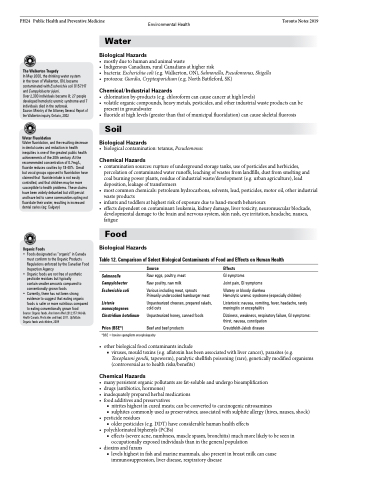Page 1242 - TNFlipTest
P. 1242
PH24 Public Health and Preventive Medicine
Environmental Health
Toronto Notes 2019
The Walkerton Tragedy
In May 2000, the drinking water system
in the town of Walkerton, ON, became contaminated with Escherichia coli O157:H7 and Campylobacter jejuni.
Water
Biological Hazards
• mostlyduetohumanandanimalwaste
• IndigenousCanadians,ruralCanadiansathigherrisk
• bacteria:Escherichiacoli(e.g.Walkerton,ON),Salmonella,Pseudomonas,Shigella • protozoa:Giardia,Cryptosporidium(e.g.NorthBattleford,SK)
Chemical/Industrial Hazards
• chlorinationby-products(e.g.chloroformcancausecancerathighlevels)
• volatileorganiccompounds,heavymetals,pesticides,andotherindustrialwasteproductscanbe
present in groundwater
• fluoride at high levels (greater than that of municipal fluoridation) can cause skeletal fluorosis
Soil
Biological Hazards
• biologicalcontamination:tetanus,Pseudomonas
Chemical Hazards
• contaminationsources:ruptureofundergroundstoragetanks,useofpesticidesandherbicides, percolation of contaminated water runoffs, leaching of wastes from landfills, dust from smelting and coal burning power plants, residue of industrial waste/development (e.g. urban agriculture), lead deposition, leakage of transformers
• mostcommonchemicals:petroleumhydrocarbons,solvents,lead,pesticides,motoroil,otherindustrial waste products
• infants and toddlers at highest risk of exposure due to hand-mouth behaviours
• effectsdependentoncontaminant:leukemia,kidneydamage,livertoxicity,neuromuscularblockade,
developmental damage to the brain and nervous system, skin rash, eye irritation, headache, nausea, fatigue
Food
Biological Hazards
Table 12. Comparison of Select Biological Contaminants of Food and Effects on Human Health
Over 2,300 individuals became ill; 27 people developed hemolytic uremic syndrome and 7 individuals died in the outbreak.
Source: Ministry of the Attorney General. Report of the Walkerton inquiry. Ontario, 2002
Water Fluoridation
Water fluoridation, and the resulting decrease in dental caries and reduction in health inequities is one of the greatest public health achievements of the 20th century. At the recommended concentration of 0.7mg/L, fluoridereducescavitiesby18-40%. Small but vocal groups opposed to fluoridation have claimedthat fluorideintakeisnoteasily controlled, and that children may be more susceptible to health problems. These claims have been widely debunked but still persist and have led to some communities opting not fluoridate their water, resulting in increased dental caries (eg: Calgary)
Organic Foods
• Foods designated as “organic” in Canada must conform to the Organic Products Regulations enforced by the Canadian Food Inspection Agency
• Organic foods are not free of synthetic pesticide residues but typically contain smaller amounts compared to conventionally grown foods
• Currently, there has not been strong evidence to suggest that eating organic foods is safer or more nutritious compared to eating conventionally grown food
Source: Organic foods. Ann Intern Med 2012;157:348-66. Health Canada. Pesticides and food, 2011. UpToDate. Organic foods and children, 2009
Salmonella Campylobacter Escherichia coli
Listeria monocytogenes
Clostridium botulinum
Prion (BSE*)
Source
Raw eggs, poultry, meat Raw poultry, raw milk
Various including meat, sprouts Primarily undercooked hamburger meat
Unpasteurized cheeses, prepared salads, cold cuts
Unpasteurized honey, canned foods Beef and beef products
Effects
GI symptoms
Joint pain, GI symptoms
Watery or bloody diarrhea
Hemolytic uremic syndrome (especially children)
Listeriosis: nausea, vomiting, fever, headache, rarely meningitis or encephalitis
Dizziness, weakness, respiratory failure, GI symptoms: thirst, nausea, constipation
Creutzfeldt-Jakob disease
*BSE = bovine spongiform encephalopathy
• otherbiologicalfoodcontaminantsinclude
■ viruses, mould toxins (e.g. aflatoxin has been associated with liver cancer), parasites (e.g.
Toxoplasmi gondii, tapeworm), paralytic shellfish poisoning (rare), genetically modified organisms (controversial as to health risks/benefits)
Chemical Hazards
• manypersistentorganicpollutantsarefat-solubleandundergobioamplification • drugs(antibiotics,hormones)
• inadequatelypreparedherbalmedications
• foodadditivesandpreservatives
■ nitrites highest in cured meats; can be converted to carcinogenic nitrosamines
■ sulphites commonly used as preservatives; associated with sulphite allergy (hives, nausea, shock) • pesticideresidues
■ older pesticides (e.g. DDT) have considerable human health effects • polychlorinatedbiphenyls(PCBs)
■ effects (severe acne, numbness, muscle spasm, bronchitis) much more likely to be seen in occupationally exposed individuals than in the general population
• dioxinsandfurans
■ levels highest in fish and marine mammals, also present in breast milk can cause
immunosuppression, liver disease, respiratory disease


